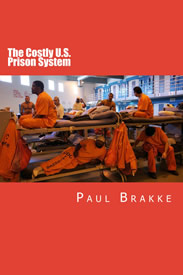FOR IMMEDIATE RELEASE
Now that the House and Senate passed the Senate reform bill and President Trump signed it before Congress adjourned for the Christmas holidays, a long-time advocate for the bill, criminal justice expert Paul Brakke, the author of two books on the prisons — “The Costly U.S. Prison System” and “Crime in America” — asks “What’s next?”
Additionally, Brakke urges that the bill can be a model for the state legislatures to pass their own bills for change in the state and local prisons, since the vast majority of prisoners are held in such prisons. For example, according to Bureau of Justice Statistics, of the 2.1 million prisoners in the U.S. in 2016, 91% or 1.9 million were in state prisons, a rate of 780 per 100,000 adults. Accordingly, Brakke plans to take his campaign for prison reform to the state governoers and legislators next.
As Brakke notes, there is widespread support for this reform throughout the U.S. A major concern has been reducing the size of the prison population, both to save costs and to provide rehabilitation and treatment to prisoners committing less serious non-violent crimes.
For example, in one public opinion poll conducted by the Benenson Strategy Group in October 2017, 70-72% of the respondents indicated it was important to reduce the prison population.
Another poll by the John D. and Catherine T. MacArthur Foundation found that 71% of the respondents supported rehabilitation or treatment as the most important consideration in sentencing someone convicted of a nonviolent crime and has a mental illness. Also, in this poll, 84% of respondents wanted local governments to provide resources for substance abuse treatment for drug abusers, as reported by Kathryn Casteel in a February 13, 2018 article on the FiveThirtyEight website.
Brakke has urged this emphasis on cost-cutting and rehabilitation, because it will also cut down on recidivism because these prisoners will be less likely to turn to crime due to improved job skills.
Plus, this approach will help bring together and support families which have been broken up due to a family member being in prison.
According to Brakke, these changes in federal sentencing law can provide a model for the states for their prisons and local municipalities for their jails. In particular, that will mean shorter sentences for deserving inmates and increased rehabilitation that can occur both in prison or jail and in the local community. In turn, prisoners will be better able to find jobs and live productive lives once back in their community. And they will be more likely to return to intact families.
Among other things, Brakke recommends the states adopt these provisions of the federal bill:
– Three-strikes prisoners should no longer face automatic life sentences; instead they should only face 25 years.
– Drug offenders who would automatically receive 20 year sentences should now face only 15 years.
– Well-behaved low-risk prisoners should get credit for participating in job-training programs and should have more opportunities to participate in early release programs.
– Corrections officers should get de-escalation training to help them better respond to inmates with mental illnesses or cognitive impairment.
Brakke also views these prison reforms as the beginning of additional reforms in the criminal justice system, described in his other books published by his publishing company, American Leadership Books, which specializes in books on crime and criminal justice
He recommends other changes in Crime in America, which provide an overview of crime patterns and how the criminal justice system works — or doesn’t. For instance, he offers suggestions on improving citizen-police relations in one chapter on policing in American. In other chapters on illegal immigration and the opioid crisis, he offers suggestions on how to deal with these problems which have been a subject of contentious debate.
And next up is a book on how to heal the divisions in U.S. society which are tearing America apart: Fractured America. In it he discusses about a dozen different divisions — from racial, ethnic, and religious divisions to divisions based on gender, age, geography, urban-rural residence, income inequality, political differences, and lifestyle. After describing the extent of these divisions, he suggests way to fix them.
To learn more, you can now get a free review copy of Crime in America, which is available for preorder, too, on Amazon. Brakke is offering these books for free to anyone who wants to review and comment on the book or learn more about his webinars and other programs — just go to www.crimeinamericathebook.com to get a copy. Also, copies are available for government officials who might turn some of Brakke’s other suggestions for reducing crime and fixing the criminal justice system into legislation. Members of the media are invited to request copies of the book, too.
To help draw attention to the suggested fixes in the book, Brakke has additionally launched a video and social media campaign with five new videos each day. The first 20 are featured on his American Leadership Books’ YouTube channel.
Among the most recent videos is “Want to Know More about U.S. Crime and Prisons?”
Brakke’s next books — “Fractured America” and “Prisons in America” — will be out in the next few months.
For media copies of the book, along with additional information on American Leadership Books and Paul Brakke, and to set up interviews, please contact:





